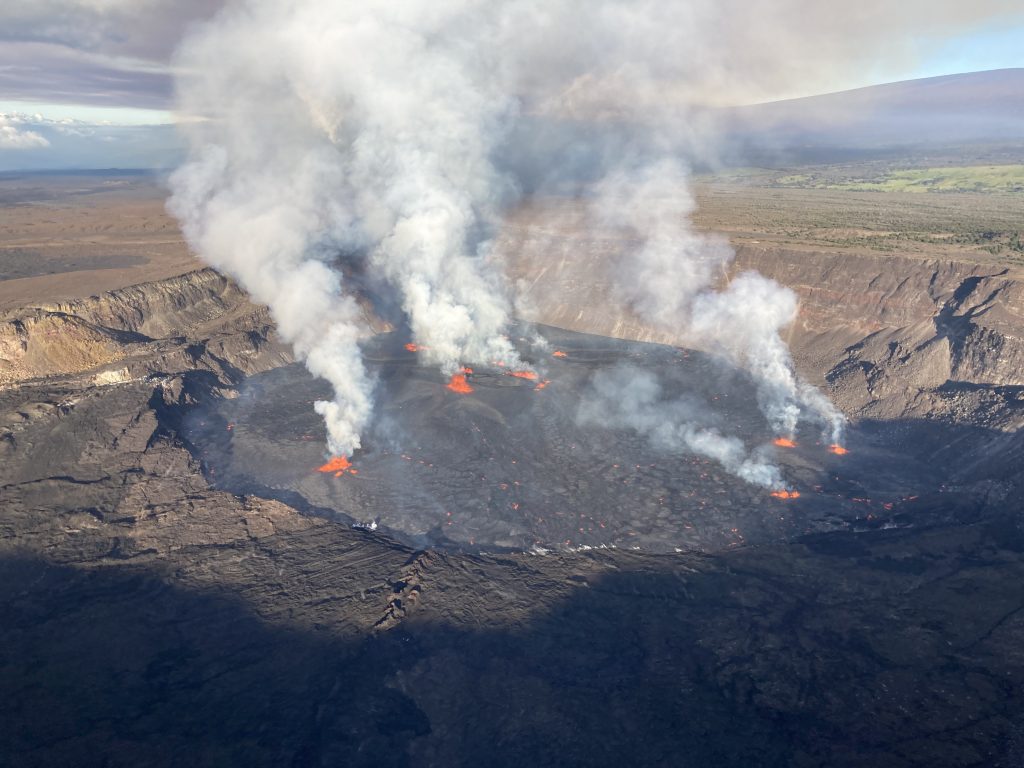Alert levels lowered for Kīlauea volcano with eruption expected to stay at summit

On Thursday morning, one day after Kīlauea began erupting at 4:44 a.m. on Wednesday, Hawaiian Volcano Observatory has lowered Kīlauea’s volcano alert level from warning to watch because the initial high effusion rates of lava and gas have declined, and no infrastructure is threatened.
Associated hazards are confined to the closed area established by Hawaiʻi Volcanoes National Park.
The observatory has lowered Kīlauea’s aviation color code from red to orange because there is currently no threat of significant volcanic ash emission into the atmosphere outside of the hazardous closed area within Hawai‘i Volcanoes National Park.
The eruption plume continues to rise to the base of the inversion level at about 8,000 to 10,000 feet above sea level as it did on Wednesday. The plume is largely composed of sulfur dioxide gas and minor volcanic particles, but in lower concentrations due to the drop in effusion rate. Hazards associated with the eruption are limited and are described below.
Kīlauea’s summit eruption is expected to continue and remain confined to Halemaʻumaʻu crater within Hawai‘i Volcanoes National Park. Scientists do not see any indication of activity migrating elsewhere on Kīlauea volcano and expects the eruption to remain confined to the summit region.
Hazard Analysis:
The eruption at Kīlauea’s summit is occurring within a closed area of Hawai’i Volcanoes National Park. Therefore, high levels of volcanic gas are the primary hazard of concern, as this hazard can have far-reaching effects downwind.
Large amounts of volcanic gas — primarily water vapor, carbon dioxide and sulfur dioxide — are continuously released during eruptions of Kīlauea volcano. As sulfur dioxide is released from the summit, it will react in the atmosphere to create the visible haze known as vog (volcanic smog) that has been observed downwind of Kīlauea.
Vog creates the potential for airborne health hazards to residents and visitors, damages agricultural crops and other plants and affects livestock. For more information on gas hazards at the summit of Kīlauea, click here. For vog information, click here.
Additional hazards include Pele’s hair and other lightweight volcanic glass fragments from the lava fountains that will fall downwind of the fissure vents and dust the ground within a few hundred yards of the vent (s). Strong winds may waft lighter particles to greater distances. Residents should minimize exposure to these volcanic particles, which can cause skin and eye irritation.
Other significant hazards also remain around Kīlauea caldera from Halemaʻumaʻu crater wall instability, ground cracking and rockfalls that can be enhanced by earthquakes within the area closed to the public. This underscores the extremely hazardous nature of Kīlauea caldera rim surrounding Halemaʻumaʻu crater, an area that has been closed to the public since late 2007.
For discussion of Kīlauea hazards, click here.





